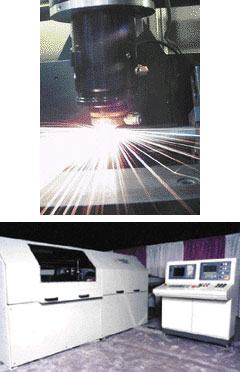Daniel C. McCarthy, News Editor
Motoman Inc., a manufacturer of robotic solutions for industrial applications, designed its new TubeStar robot to produce high output of cut metal tubing at low operating costs. This sort of production formula suggests a photonics solution, and as evidence of this Motoman had used Nd:YAG lasers in earlier iterations of the TubeStar. In its newest generation of the tube-cutting robot, however, the company opted to incorporate Rofin-Sinar's DC010 diffusion-cooled CO2 laser.

Motoman Inc. opted to replace the Nd:YAG laser with CO2technology when it redesigned its TubeStar tube-cutting robot. The primary motive, reduced operating cost, also prompted Motoman to select Rofin-Sinar's DC010, which it says operates at half the cost of other CO2 lasers.
"Motoman used to support YAG applications, but the investment per watt of YAG lasers was prohibitive at $175 per watt," said Gary Keller, thermal cutting process sales manager at Motoman. "Plus there were issues with fibers in the past."
Keller began searching for a CO2 laser that could reduce by 10 to 20 percent the investment capital required for a TubeStar system as well as boost the production rate by 30 percent. He selected Rofin-Sinar's 1000-W laser because it operates at half the cost per watt of competitive CO2 lasers he considered, while providing the same beam quality.
The new TubeStar can produce more than 300 segments an hour, including finer detail work such as creating saddle joints or drilling holes. Motoman reports that once raw stock has been loaded into a magazine feeder, the TubeStar can run for up to four hours without intervention. "We've actually achieved production that is 100 to 150 percent higher [than earlier systems], while costing $6 per hour to operate," Keller said.
Another benefit Keller noted for Rofin-Sinar's laser is its diffusion-cooled technology. There are no moving parts such as turbines or root blowers that can break down. "The only part costs are the replacement of the radio frequency tube, filters and the gas bottle," Keller said. "But the overall operating cost of Rofin-Sinar's laser is still very low."